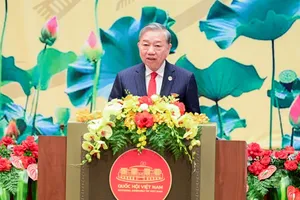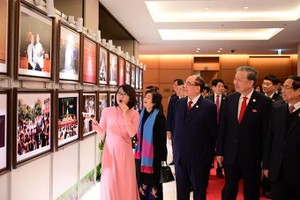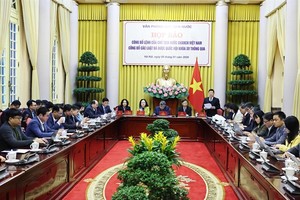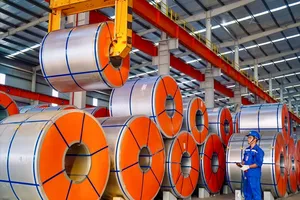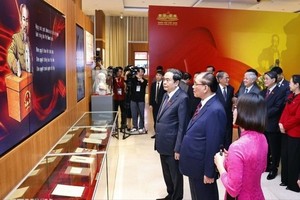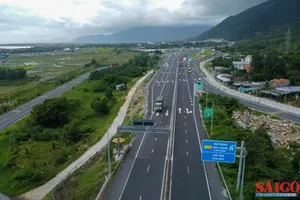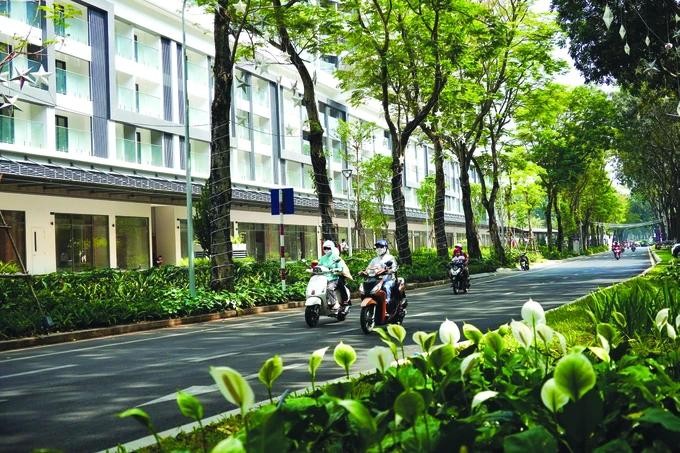
The Ministry of Construction reports that the nation presently possesses over 400 green buildings, with a total floor space of almost 10 million square meters. Incorporating green spaces in commercial building design has many benefits. Trees, shrubs, and other vegetation act as natural air filters, absorbing pollutants and releasing oxygen, thus improving air quality.
The notion of green buildings has emerged in the Vietnamese construction sector for around 15 years. Ho Chi Minh City alone is currently leading the country in the number of green buildings, with about 70 projects; for instance, the Gamuda - Elysian high-rise apartment complex in Thu Duc City is one of examples of green building in the southern metropolis. Thanks to its special architectural designs, residents in the Gamuda - Elysian high-rise apartment complex in Thu Duc Cit can access gardens arranged on high, close to the living space. In addition, all materials of the project emit few harmful substances.
Similarly, constructors of the NRG Office project of Artelia Company in Da Kao Ward of HCMC’s District 1 used most of recycled materials for the project with sustainable and environmentally friendly interior products.
Meanwhile, people in the sectors have recently mentioned to the new headquarters project of the Vietnam Securities Depository Center on Hoang Quoc Viet Street in Hanoi’s Bac Tu Liem District - a typical green building.
The project has obtained the Silver LOTUS Green Building accreditation from the Vietnam Green Building Council as it is evaluated to conserve up to 49 percent of energy and 48 percent of water relative to a comparable building constructed to minimum standards.
However, Architect Hoang Manh Nguyen from the Institute of Green Urban Science and Technology assessed that the initial pace of development in Vietnam is comparable to that of Southeast Asian nations; however, the execution and progress of green building construction in the country are experiencing delays.
The present quantity of green buildings remains relatively low when compared to the total number of constructions in certain countries within the region, as well as in relation to the established targets. Specifically, Vietnam has yet to develop any structures that are designed, constructed, managed, and operated in accordance with the standards for zero net emission buildings.
However, Architect Hoang Manh Nguyen said that construction of green buildings in Vietnam are voluntarily done by investors for a long time without encouragement from management agencies.
Director Mai Thi Lien Huong of the National Institute of Architecture has highlighted that over the past decade, buildings in Vietnam have been responsible for approximately 36 percent of the nation's total energy consumption. Additionally, they have contributed to 25 percent of the overall greenhouse gas emissions, which represents one-third of the total CO2 emissions, a significant factor in global climate change.
By 2030, it is projected that Vietnam's urban population will rise to 45 percent, necessitating the construction of approximately 70 million square meters of urban housing annually. Consequently, the construction sector will play a significant role in reducing emissions. This underscores the urgent need to advance green construction practices, which will significantly support sustainable economic development.
Global studies have shown that although green buildings require an increase in investment capital of 3 percent - 8 percent compared to conventional investment, they save 15 percent - 30 percent of energy use while reduce 30 percent - 35 percent of carbon emissions, 30 percent - 50 percent of water use, and 50 percent - 70 percent of waste treatment costs.
The costs and benefits associated with green buildings in Vietnam have been assessed; however, the existing policy mechanisms lack enforceability, resulting in insufficient attention from investors on this matter.
Experts in the construction industry emphasize that to advance the development of green buildings, it is essential to establish specific legal regulations and supportive policies.
Architect Do Thanh Tung from the Vietnam Association of Architects asserts that a green design will pave the way for quality green buildings.
He pointed out that In recent times, green buildings using unburnt bricks, bamboo, straw, low-emission glass, concrete from blast furnace slag of architects Hoang Thuc Hao, Vo Trong Nghia, Doan Thanh Ha have won many domestic and international awards but not many such green designs are seen. He also emphasized the crucial use of green materials.
The construction materials industry is highly energy-intensive and consumes significant natural resources. Thus, encouraging the industry’s shift towards “greening” will positively impact the broader effort to green the economy and promote sustainable development.
Director Vu Ngoc Anh of the Department of Science, Technology and Environment under the Ministry of Construction said that the greening of the construction materials industry faces many difficulties due to the high cost of investment, upgrade of production lines and equipment for the production of green construction materials. Meanwhile, there are not many legal framework at present to support mechanisms and policies specifically and the capacity and technology of firms producing green construction materials in the country are also limited, the cost of products is still high, so the consumption is low.The feasibility of developing green buildings will only improve when there is an ample, diverse, and high-quality supply of green construction materials available at reasonable prices.
Making a more specific proposal for promoting green building development, engineer Nguyen Xuan Hai, Project Management Institute (PMI) of the United States, said that there must be a financial support fund for green building projects, energy-efficient buildings, resource-saving buildings or similar types of buildings.
The government must collaborate with financial institutions to offer loans at favorable interest rates for such projects. Utilizing tax incentives can serve as a powerful strategy to influence investor behavior and encourage green investments. Furthermore, it is essential to establish favorable conditions and priorities during the construction permitting process and other formalities.


